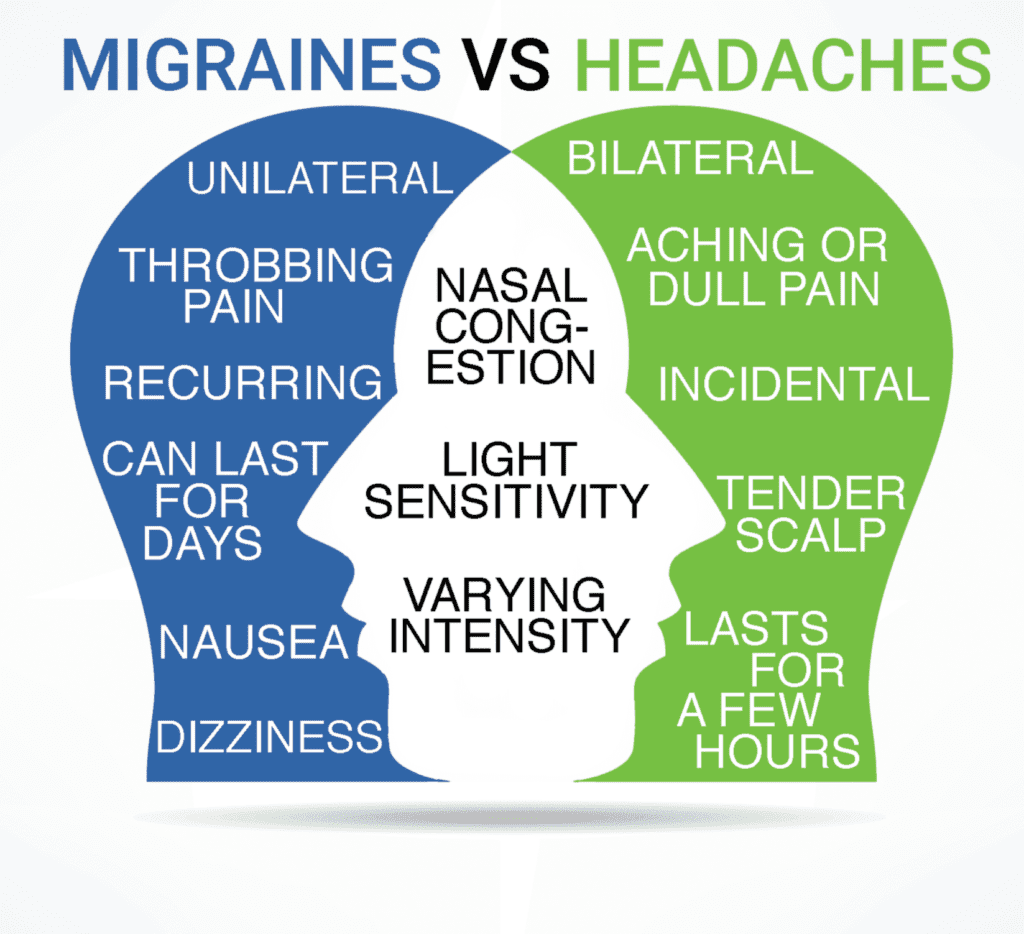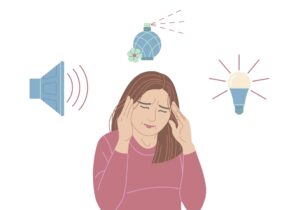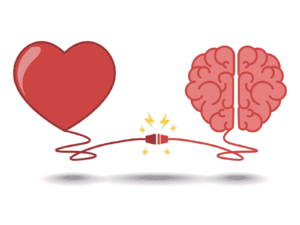Is Migraine dangerous? Migraine can be a debilitating condition affecting millions of people worldwide. It affects 20% (1 in 5) of all women and 1 in 16 men. It is characterized by intense and often disabling headaches, nausea, vomiting, and sensitivity to light and sound. While it may not be life-threatening, migraine can significantly impair your quality of life.
Understanding the risks and symptoms associated with this condition is essential for managing it effectively. In this article, we will explore the dangers of migraine and discuss how to identify their signs to reduce your risk of experiencing a severe attack.
What is a Migraine?
Migraine is a neurological disorder characterized by recurrent attacks of moderate to severe headaches. These episodes are often accompanied by nausea and sensitivity to light, sound, and smell.
A migraine attack can vary in intensity and duration but typically lasts 4-72 hours. It can be associated with other symptoms such as visual disturbances (called aura), fatigue, numbness, and dizziness.
The Difference Between Migraine and Headache
Migraine is not just a bad headache. While many people experience headaches, migraine attacks can be much more severe and disabling. Headaches are basically a general term for any discomfort above the neck in the head. There are many types of headache disorders. Migraines are a very specific type of headache disorder. Other symptoms, such as nausea and vomiting, sensitivity to light and sound, dizziness, numbness or tingling sensations in the face or extremities, and visual disturbances, often accompany migraines.
The Four Stages of Migraine Attack
Migraine attacks typically progress in four distinct phases: prodrome, aura, headache, and postdrome. During the prodrome stage, patients may experience subtle changes in mood or behavior that occur a few hours to days before the attack. Some people may have visual disturbances, such as flashing lights or zigzag lines, during the aura stage.
The most severe headache phase typically lasts 4-72 hours. Finally, the postdrome phase can last up to 24 hours after an attack and may include feelings of exhaustion, confusion, difficulty concentrating, or euphoria.
The Genetics of Migraine
Migraines can be hereditary and can run in families. It typically begins during childhood or adolescence but can also occur in adults with no history of migraine headaches. Certain lifestyle factors such as stress, lack of sleep, certain foods, and certain medications may trigger or exacerbate attacks.
Understanding Migraine Symptoms
The Common Symptoms of Migraine
Some of the common symptoms of a migraine include the following:
- Intense pulsating or throbbing headache typically on one side of the head
- Nausea and vomiting
- Sensitivity to light, sound, and smells
- Visual disturbances (aura)
- Fatigue
- Numbness or tingling sensations in the face or extremities (aura)
- Speech disturbances such as slurred speech or getting words out correctly (aura)
- Dizziness
How to Identify Migraine Triggers
To reduce your risk of experiencing a migraine attack, it’s crucial to identify and avoid potential triggers such as stress, lack of sleep, bright lights, certain foods and drinks (e.g., caffeine or alcohol), changes in the weather, and high altitudes.
The Importance of Keeping a Migraine Diary
Keeping a migraine diary can help you identify potential triggers and keep track of your symptoms. Be sure to note the time, duration, severity, and other symptoms associated with each attack. I always tell patients to mark down an “M” for migraine if there is any throbbiness (even if very low level), nausea, sensitivity to light and sound.
If it lacks these features and is more of a dull achy pressure type pain, then mark a “T” for tension type headache. This will help create an effective treatment plan with your doctor.
What Causes Migraine?
The exact cause of migraine is unknown. However, it is believed to be related to abnormal brain electrical activity and blood vessel changes, influenced by genetic and environmental factors. Other possible causes include environmental triggers such as stress, certain foods or beverages, food additives, bright lights, and changes in the weather.
The Role of Genetics in Migraine
Genetics can also play a role in migraine susceptibility. If you have a family history of migraine, you will likely be more susceptible to the condition.
The Impact of Hormones on Migraine
Hormonal changes can also play a role in migraine susceptibility. Fluctuations of estrogen and progesterone, such as during the menstrual cycle, pregnancy, menopause, or taking oral contraceptives, may make women more susceptible to migraine attacks. The drop in estrogen prior to a menstrual cycle, or during the placebo days of oral birth control pills, is the most common cause of menstrual migraine.
The Connection Between Migraine and the Environment
Environmental factors like certain smells or bright lights can also trigger migraine attacks. Keeping a migraine diary can help you identify potential triggers and provide clues for creating an effective treatment plan with your doctor.
Is Migraine Dangerous?
Migraine is not a dangerous condition, although it can certainly feel like you’re dying! However, it can be painful and disruptive. If you experience frequent or severe migraine attacks, discussing your symptoms with your doctor is important.
The Risks of Chronic Migraine
Chronic migraine is defined as experiencing 15 or more days of headache per month, with at least 8 of those days having migraine features, for at least three months. If left untreated, this migraine can lead to other serious health problems, such as depression and anxiety.
Additionally, chronic headaches can interfere with your ability to work or go about your daily activities. Migraine is now ranked as the second leading cause of years lived with disability globally following low back pain. It is the leading cause in women in their prime working years!
So putting those numbers in perspective, it is a tremendously disruptive disorder. This is why it is so important to seek treatment if you are experiencing frequent migraine attacks. The more that migraine goes untreated without an effective abortive and preventive treatment plan, the more frequent and severe it often becomes.
The Link Between Migraine and Stroke
Although rare, migraine may slightly increase your risk of stroke. This is most likely to occur in people who experience auras with migraine attacks. Young women under age 45 who have migraine with aura, who are on estrogen birth control, and who are smokers have the highest risk of migraine associated stroke. It is important to talk to your doctor if you are experiencing frequent or severe migraine attacks.
The Psychological Effects of Migraine
Migraine can also have a significant impact on your mental health. It can lead to depression or anxiety and difficulty sleeping or concentrating. If you are experiencing any of these symptoms, it is important to talk to your doctor.
Migraine Treatment and Prevention
Migraine is a disabling neurological disorder that can cause intense headaches, nausea, and other symptoms. While the exact cause of migraine is unknown, it is believed to be related to abnormal activity in the brain and changes in the blood vessels. Fortunately, several treatment options that target these causes are available for those suffering from migraine attacks.
Medication Options for Migraine
Migraine medications, such as triptans, gepants, DHE, ditans, or over the counter pain relievers, can be used to manage migraine symptoms acutely (as needed). Additionally, medications can also be prescribed to prevent future migraine attacks. These include daily medicines, gepants (Nurtec, Qulipta), once monthly self-injections (Aimovig, Ajovy, Emgality), once quarterly 30 minute IV Vyepti, Botox, supplements, and neuromodulation devices.
Non-Medication Migraine Treatment Options
Non-medication options for migraine management include lifestyle changes, such as reducing stress and avoiding triggers, as well as relaxation techniques like yoga or meditation. Additionally, acupuncture, acupressure, and biofeedback can also be used to manage migraine symptoms.
Preventative Measures for Migraine
Preventative measures, such as avoiding triggers and managing stress, can be taken to reduce the frequency and severity of migraine attacks. Additionally, it is essential to talk to your doctor about any changes in medication or lifestyle that might benefit your condition.
Conclusion
Migraine is a common and debilitating condition affecting people of all ages. While the exact cause is complex and includes genetic and environmental factors, potential triggers such as stress, hormones, certain foods or beverages, bright lights, and changes in the weather can exacerbate the condition.
Identifying these triggers and discussing your symptoms with your doctor is important to create an effective treatment plan. Additionally, keeping a migraine diary can help you identify potential triggers and monitor the severity of your symptoms. By understanding the causes and risk factors of migraine, you can take steps to reduce your risk of experiencing attacks in the future.
FAQs:
Q. What are the most common symptoms of migraine?
The most common migraine symptoms include a severe and often throbbing headache which may predominate to one-side, nausea +/- vomiting, sensitivity to light and sound, and possibly vision changes such as auras (in 30% of patients).
Q. How do I know if I have a migraine or a headache?
Migraine headaches are usually more severe and often accompanied by other symptoms such as nausea, sensitivity to light and sound, and possibly vision changes. If you are experiencing a headache accompanied by these additional symptoms, it is essential to talk to your doctor about the possibility of a migraine.
Q. Can migraines lead to long-term health issues?
Yes, if left untreated, chronic migraine can lead to other serious health issues, such as depression and anxiety. Additionally, chronic headaches can interfere with your ability to work or go about your daily activities. It is important to seek treatment if you are experiencing frequent or severe migraine attacks.
Q. What are the best treatment options for migraine?
The best treatment options for migraine include abortive and preventive medications and other treatments, lifestyle changes, and relaxation techniques. Additionally, preventative measures such as avoiding triggers and managing stress can also be taken to reduce the frequency and severity of attacks. It is important to talk to your doctor about any changes in medication or lifestyle that might benefit your condition.
Q. How can I prevent migraines from occurring?
The best way to prevent migraines from occurring is to identify and avoid triggers. Additionally, lifestyle changes such as reducing stress and getting adequate sleep can also help manage symptoms. There are many preventive medications and non-medicine preventive treatment options when conservative measures are not helping, or frequency is worsening. It is essential to talk to your doctor about any changes in medication or lifestyle that might benefit your condition.
IF YOU HAVE HEADACHE, MIGRAINE, OR FACIAL PAIN AND ARE LOOKING FOR ANSWERS ON ANYTHING RELATED TO IT, A HEADACHE SPECIALIST IS HERE TO HELP, FOR FREE!
FIRST, LET’S DECIDE WHERE TO START:
IF YOU HAVE AN EXISTING HEADACHE, MIGRAINE, OR FACIAL PAIN DIAGNOSIS AND ARE LOOKING FOR THE LATEST INFORMATION, HOT TOPICS, AND TREATMENT TIPS, VISIT OUR FREE BLOG OF HOT TOPICS AND HEADACHE TIPS HERE. THIS IS WHERE I WRITE AND CONDENSE A BROAD VARIETY OF COMMON AND COMPLEX MIGRAINE AND HEADACHE RELATED TOPICS INTO THE IMPORTANT FACTS AND HIGHLIGHTS YOU NEED TO KNOW, ALONG WITH PROVIDING FIRST HAND CLINICAL EXPERIENCE FROM THE PERSPECTIVE OF A HEADACHE SPECIALIST.
IF YOU DON’T HAVE AN EXISTING HEADACHE, MIGRAINE, OR FACIAL PAIN DIAGNOSIS AND ARE LOOKING FOR POSSIBLE TYPES OF HEADACHES OR FACIAL PAINS BASED ON YOUR SYMPTOMS, USE THE FREE HEADACHE AND FACIAL PAIN SYMPTOM CHECKER TOOL DEVELOPED BY A HEADACHE SPECIALIST NEUROLOGIST HERE!
IF YOU HAVE AN EXISTING HEADACHE, MIGRAINE, OR FACIAL PAIN DIAGNOSIS AND ARE LOOKING FOR FURTHER EDUCATION AND SELF-RESEARCH ON YOUR DIAGNOSIS, VISIT OUR FREE EDUCATION CENTER HERE.







